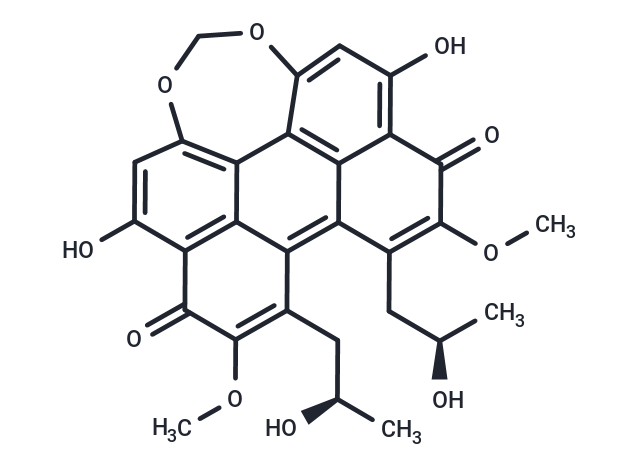Shopping Cart
- Remove All
 Your shopping cart is currently empty
Your shopping cart is currently empty

Cercosporin, produced by the plant pathogen Cercospora kikuchii and the elsinochromes, is a potent photosensitizer with a short activation wavelength. Cercosporin contains perylene quinone structural features essential for PKC activity (IC50: 0.6-1.3 μM).


| Description | Cercosporin, produced by the plant pathogen Cercospora kikuchii and the elsinochromes, is a potent photosensitizer with a short activation wavelength. Cercosporin contains perylene quinone structural features essential for PKC activity (IC50: 0.6-1.3 μM). |
| Targets&IC50 | PKC:0.6-1.3 μM |
| In vitro | Cercosporin (0-3 μΜ; 24 hours) interplays with copper results in synergistic cytotoxicity in MCF7 and T98G cells, that is, S(CuSO4 + Cerco) ? S(CuSO4) x S(Cerco), barely has an additive effect in U87 cells. Cercosporin (0.8-8.0 μM; 30 s, 60 s, 90 s, 120 s) photodynamic therapy effect is stronger in T98G cells than in U87 or MCF7 cells, the LD50 value for the T98G cells (0.14 J cm2) is much less than the LD50 value for MCF-7 and U87 cell lines (0.26 and 0.24 J cm2, respectively) [1]. |
| Molecular Weight | 534.51 |
| Formula | C29H26O10 |
| Cas No. | 35082-49-6 |
| Relative Density. | 1.59g/cm3 |
| Storage | Powder: -20°C for 3 years | In solvent: -80°C for 1 year | Shipping with blue ice. |

Copyright © 2015-2025 TargetMol Chemicals Inc. All Rights Reserved.